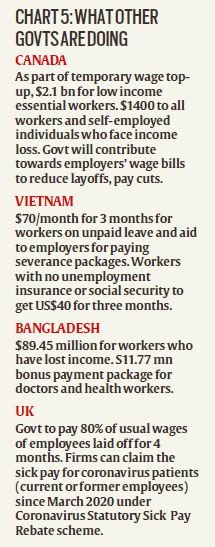Labour Laws in India: Purpose, History, Ongoing reforms

From Current Affairs Notes for UPSC » Editorials & In-depths » This topic
IAS EXPRESS Vs UPSC Prelims 2024: 80+ questions reflected
The labour laws in India have been on the anvil for the last few years now. In addition to that, the pandemic has brought upon huge investment opportunities. The employment scenario has taken a dent too. So, both in anticipation of investment incomings and to strengthen the efforts in employment creation, many state governments have taken to the task of reforming its labour laws. In this scenario, it is opportune to study the status of labour laws in India.
What are labour laws?
- Labour law is a body of laws and regulations which deals with the legal rights of, and restrictions on, working people and their organizations.
- It mediates multifaceted aspects of the relationship between the stakeholders: trade unions, employers, and employees. Labour law defines the rights and obligations of the workers, union members, and employers in the workplace.
- Generally, labour law covers:
- Industrial relations – certification of unions, labour-management relations, collective bargaining and unfair labour practices;
- Workplace health and safety;
- Employment standards, including general holidays, annual leave, working hours, unfair dismissals, minimum wage, layoff procedures, and severance pay.
Why is there a need to have labour laws?
- It brings in effect a legal system to facilitates organizations and collective employment relationships resulting a productive economy;
- It provides a framework for the employers, workers and, their representatives to interact with regard to work-related issues. It acts as a vehicle for achieving harmonious industrial relations based between the stakeholders;
- It provides a guarantee of fundamental principles and rights at work that have received broad social acceptance. It also establishes the processes through which these principles and rights can be enforced.
Evolution of labour laws in India
- British Rule
- The industrial/labour legislation enacted by the British were primarily intended to protect the interests of the British employers. Considerations of British economic interests were the priorities in shaping some of these early laws.
- The Factories Acts, 1883 and 1893- It was the first labour law by British which stipulated eight hours of work, the abolition of child labour, and the restriction of women in night employment, and the introduction of overtime wages for work beyond eight hours.
- The earliest Indian statute to regulate the relationship between employer and his workmen was the Trade Dispute Act, 1929 (Act 7 of 1929). Provisions were made in this Act for restraining the rights of strike and lockout but no machinery was provided to take care of disputes.
- Post-independence labour laws
Free India’s labour law framework began with the Industrial disputes Act, 1947 as independent India called for a clear partnership between labour and capital. The base of this partnership was unanimously approved in a tripartite conference in December 1947. It was in this conference that labour would be given a fair wage and working conditions and in return capital would receive the harmonious co-operation of labour for uninterrupted production and higher productivity as part of the strategy for national economic development.
There is an entire gamut of labour laws in India. Let us see some of the important ones.
- The Factories Act, 1948– It deals with important provisions like working hours, Safety, facilities and convenience of the workers, Employment conditions for women, etc.
- The Minimum wages act, 1948– Stipulates minimum wages to be paid to the skilled and unskilled labour.
- The Industrial Disputes Act, 1947-The objective of the Industrial Disputes Act is to secure industrial peace and harmony. It seeks achieve it through mechanism and procedure for the investigation and settlement of industrial disputes by conciliation, arbitration, and adjudication which is provided under the statute. This law applies only to the organized sector.
- Child Labour (Prohibition) Act- The act prohibits employing children below 14 years of age in hazardous jobs.
- The Employment State Insurance Act– It covers the employees’ health protection facilities against potential injuries, sickness at work and other issues.
What is the need to codify the labour laws?
- As labour is in the concurrent list, there was an entire gamut of 200+ state and 40+ central laws with often colluding jurisdictions.
- The multiplicity, rigidity, and overlapping nature of laws also makes compliance difficult which leads to inspector raj like conditions even now. This leads to corruption, exploitation of workers, etc
- The above situation also hampers the ease of doing business in India.
- India has a huge informal sector, with almost 90% workforce engaged in it. The labour laws largely ignore the sector.
- The companies have an incentive in keeping their firm small as larger firms attract stricter regulations.
- The contract employment always generates aversion from labours. There is a need to introduce fixed-term employment.
- The female labour force participation is very low and it is mainly engaged in the informal sector and low-paid jobs.
- The collective bargaining of the employees is weak. It needs to be strengthened.
- The codification of labour laws was recommended by the 2nd National commission on labour (2002).
The four codes
- The Code on Wages
- The code been passed by the parliament. The draft rules have been made public and are under discussion.
- The laws that are codified under the code on wages are
- Payment of Wages Act, 1936;
- Minimum Wages Act, 1948;
- Payment of Bonus Act, 1965;
- Equal Remuneration Act, 1976
- The Code on Industrial relations
- It has been introduced in the parliament and is under discussion.
- It attempts to offer some degree of flexibility on government permissions for retrenchment and presents the legal framework for ushering in the concept of ‘fixed-term employment’ through contract workers on a pan-India basis.
- The laws brought under the code are
- Trade Unions Act, 1926;
- Industrial Employment (Standing Orders) Act, 1946
- the Industrial Disputes Act, 1947
- The Code on social security
- The code on social security has been introduced in the parliament and it is with the standing committee.
- It strives to amend and consolidate the laws relating to the social security of the employees and the matters connected to social security.
- It codifies 9 laws including
- a) Employee’s Compensation Act, 1923;
- b) Employee’s State Insurance Act, 1948;
- c) Employees’ Provident Funds and Miscellaneous Provisions Act, 1952;
- Maternity Benefit Act, 1961;
- Building and Other Construction Workers Cess Act, 1996;
- Unorganized Workers’ Social Security Act, 2008, etc.
- The Code on Occupational Safety, Health, and Working conditions
- It has been introduced in the parliament, and s with the standing committee.
- This is the first single legislation prescribing standards for working conditions, health, and safety of the workers.
- It replaces 13 labour laws including
- a) The Factories Act, 1948
- b) Mines Act, 1952
- c) Building and Other Construction Workers (Regulation of Employment and Conditions of Service) Act, 1996;
- d) the Contract Labour (Regulation and Abolition) Act, 1970, etc.
Why is the labour reform in news during the COVID-19 pandemic?
This month, May, 2020, a number of states have made significant changes in the application of the labour laws. The changes have been brought to attract new investment and give a boost to the pandemic-hit economy.
The states and corresponding changes are
- Gujarat
- The state government has decided to set aside 33000 hectares of land for businesses allocation of which is to be done within 7 days.
- The new industrial establishments have been exempted from all labour laws barring few like the Minimum wages act, Industrial safety rules, Employees’ compensation act, etc.
- Madhya Pradesh
- The factory inspection rules have been relaxed with no inspection for 3 months.
- Establishments with up to 100 workers can hire according to their needs.
- The shift hours have been raised to 12 hours from 8 hours.
- Uttar Pradesh
- UP government brought an ordinance that goes for blanket suspension of labour laws applicable to all kinds of enterprises for a period of three years barring few laws.
- Workers would lose key rights including the right to form Unions, the right to raise industrial disputes, etc.
- Rajasthan
- It has raised working hours to 12 hours
- The state also has amended the Industrial Disputes Act to increase the threshold for lay-offs and retrenchment to 300 from 100 earlier.
- In order to recognize the trade union, the threshold membership of the trade union has been increased from 15 percent to 30 percent.
- Kerala
The State CM has said that if the investor agrees to complete formalities in a year, the state government would facilitate a new industrial license within a week after the application is filed.
- Punjab
The state also has amended the Factories act to raise working hours to 12 hours and make 72 hours a week working.
What was the need to bring in these reforms?
- The pandemic has brought economies to a standstill. There are huge job losses with newspaper reports suggesting 2 out of three workers have lost their jobs during the lockdown period. As per data from the Centre for Monitoring Indian Economy (CMIE), nearly 9.13 crore small traders and labourers have lost employment in April 2020.
- The states felt that relaxing the regulations will attract investments.
- The lesser compliance is thought to protect small businesses from shutting down under economic pressures.
- The companies will need some relaxations to make necessary cost-cuttings if they cannot go for lay-offs.
- It will help in reviving the economy after the lockdown. The IMF has downgraded the growth forecast for India to 1.9% for the current economic year. There are fears that the economy actually might be in negative growth trajectories.
- There are reports that many multinational companies are looking to move their production bases from China. The states are eager to attract these companies.
What are the concerns raised over the labour law relaxations?
- Though Industries have welcomed the actions, the trade Unions and social think tanks have called the act of labour law relaxation “Elimination of labour laws” in the name of reforms.
- The experts call this as “creating an enabling environment for exploitation”.
- The governments have turned its stand from directing not to fire workers and pay full wages during the pandemic. They have stripped the bargaining power of the workers.
- There is a potential for wages fall if the relaxations are put in place effectively.
- The companies may now suspend/downgrade many necessary facilities like medical facilities, drinking water, special facilities for women like creche, protective gears, etc.
- The past experiments have shown that dismantling worker protections, relaxation of labour laws may not bring in investments.
- The steps far from creating demand and revive economy, may actually be counter-productive in long-term. It’s a step back from industry cries of formalization.
- The relaxations lead to forced labour which is against the constitutional protection under article 23. It is said to be a lead towards modern slavery.
How are the other countries responding to the economic situation?
Source: Indian Express Newspaper
Way forward
- Experts believe that we could have taken a leaf out of other countries books and should have partnered with the industry and allocated 3% or 5% of the GDP towards sharing the wage burden and ensuring the health of the labourers.
- The companies should be given exemptions from EPF contributions, if they don’t lay off workers. Though this will make a dent to social security efforts, it will help in cost-cutting for companies in short term. The government may also pitch in for companies and pay the company contribution.
- Companies themselves are engaging in positive responses. Asian Paints is raising staff salaries or going ahead with annual increments to boost their morale amid the coronavirus pandemic. The steps like these will help in government actions to avoid political economy fallouts.
- The International Labour Organization (ILO), responding to the sweeping changes in labour laws proposed by state governments, has asked the authorities to ensure that all such relaxations adhere to global standards and are employed after proper consultation.
- The commentators like Thomas Friedman have suggested that companies may not leave China as they could find it more equipped to tackle the issues like pandemics more effectively. Hence the underlying logic of relaxing the laws will fall apart and lead to social tensions instead.
- The government must act in line with the codification of the labour laws. Any extension to the finalization of codes will only hamper the long-term health of the economy.
Conclusion
The pandemic has left economies world-over under sever pressures to balance the socio-economic needs of the vulnerable and the needs of the struggling industries. The balance must be found so as to minimize the risks to both the stakeholders. Any knee-jerk reaction will only hamper the process of economic revival. India should keep in mind the long-term goals of economy while dealing with the ongoing pandemic. The constitutional mandate under directive principles should be repsetced.
Practice Question for Mains
The Labour reforms by some states during the COVID-19 pandemic are less effective than they appear. Elaborate. (250 words)
If you like this post, please share your feedback in the comments section below so that we will upload more posts like this.




Hi sir,
It would be very useful ,if you can make the mindmaps in downloadable format .
We are struggling to take down points in digital format as the image cannot be zoomed in and looks blurred while zoomed out
Gold or more members can download PDFs